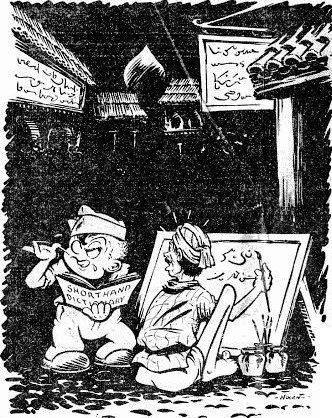
VOL. II NO. 2 REG NO. L5015 DELHI, THURSDAY SEPTEMBER 23, 1943.
|
WEATHER SLOWS UP HEAVY BOMBERS,
BUT P-40'S HELP TIGHTEN SLACK
(Written specially for the Roundup by the Public Relations Office of the 10th Air Force.)
The 10th Air Force this week continued its attacks on Japanese communications and installations. Weather hindered our heavy bombers, but P-40's went into action with a vengeance. Mediums carried on with their usual effectiveness.
No interceptions by the enemy were reported during the week but one of our photographic ships failed to return from a mission over Burma. This is the second loss of a photo reconnaissance plane this month. Jap radio claimed both as fighters. This is the cost of an amazing job of aerial picture-taking accompanied by our photo pilots all through the monsoon.
heavy bomber operations on Sept. 12 were handicapped by clouds. Results were unobserved in attacks on Meiktila Aerodrome and on Ramree Island and visibility was only fair over the Yamethin railroad yards. Heavy damage was reported to tracks and rolling stock there and the engine sheds were left in flames.
B-25's IN ACTION
B-25's were active in a number of places on the same day although weather hampered observation. Pyawbwe, Thazi Junction, Budalin, Meiktila, and Pakokku were attacked with destruction to buildings, tracks and rolling stock.
Mediums had the spotlight on the 13th. Sidings, rolling stock and the docks were hit at the railroad ferry terminal of Sagaing. Bhamo, on the upper Irrawaddy, was attacked and near hits on a large river boat were scored. Dock installation were damaged and fires left burning. At Lonkin in northern Burma, several barracks were destroyed and a large fire was started.
Again on the 14th, medium bombers heavily damaged tracks and rolling stock at Kanbalu in central Burma, the P-40's did heavy damage to enemy supply bases in the Hukawng Valley and the heavies dropped 12 tons of bombs on Jap headquarters at Myitkyina.
SUPPLY BASE HIT
The fighters and the mediums were out in force on Sept. 15 and 16. The fighters attacked in the Hukawng Valley again on both days. Ninghu Ga, forward supply base and water transshipment point for the Japanese, was bombed and strafed, as were outposts at Sharaw Ga, Ningbyen and Kantau.
The mediums caused extensive damage to the railroad reversing station at Sedaw by direct hits on the intricate system of switchbacks and by landslides caused by bombs. All bombs fell in the target area at Myingyan yards, but results were not reported, and rail installations were also hit at Wetwun and at Pwekawk. At the latter place, several storage buildings were smashed. Additional tracks and rolling stock were destroyed and damaged in attacks on Ywataung and the Sagaing Ferry terminal. Rounding off the two days activities, Japanese headquarters at Maymyo were heavily bombed.
B-25's attacked Naba Junction and Bongyaung gorge on the 18th. At the latter target, they duplicated their attack on Sedaw by causing landslides, covering a large section of the tracks at the bottom of the gorge.
The mediums the next day made a concentrated attack on Monywa, capital of the Chindwin district. Damage was widespread in the dock areas an central sections of the city and several direct hits on the power station were observed. Enemy-occupied barracks were destroyed also.
The B-24's followed up the attack by the mediums on Monywa. One formations made 60 hits on warehouses, tracks, and rolling stock. Another formation rained high explosives on the barracks.
The B-25's and the P-40's combined in an attack on Lonkin on the same day. The P-40's also left a large fire burning at Ningchangyang.
Heavy bombers delivered nearly 20 tons of bombs on the Sagaing ferry terminal on Sept. 20. Low-altitude bombing by B-25's destroyed storage buildings, rolling stock and tracks in the Naba railroad yards. Subsequent strafing left many fires burning. Another formation demolished supply buildings and tracks at Indaw, south of Naba.
15 More Zeros Liquidated By 14th Air Force
(The following story was written in the Roundup office from communiqu s received from C.B.I. Forward Echelon HQ.)
During the period of Sept. 11-18, the hard-hitting 14th Air Force was in the air five days, brushed 15 more Jap planes out of the sky for certain while losing four and continued to pound enemy installations and communications with unremitting fury.
Greatest toll of Jap planes was sent flaming earthwards Sept. 15 when B-24's attacked the cement plant and adjacent installations at Haiphong with unobserved results. The enemy screamed up to intercept, but when the fracas was over he had lost 10 Zeros confirmed and 18 probables. The communiqu , which covered three other actions, announced three of our planes lost and, amplifying the major scrap, added: "Many other enemy planes are believed to have been destroyed during this action."
WUCHANG BOMBED
On the same day, B-25's, escorted by P-40's, bombed Jap installations at Wuchang, scoring many hits on warehouses and bagging one Zero.
Next day, reported the same communiqu , B-24's, escorted by P-40's, scored direct hits upon an enemy concentration point southwest of Tayeh, detonating ammunition dumps and destroying warehouses and barracks.
It concluded with a report of B-25's with fighter escort bombing an iron foundry at Shihhweiyao and scoring hits on the foundry, cranes, warehouses and adjacent rail installations.
ATTACK BY P-38'S
At week's start (Sept. 11), P-38's made a low-level attack against Jap shipping in Hong Kong Harbor. Three ships of over 500 feet were attacked. Two were damaged. A destroyer was dive-bombed off Sanchu Island and left burning after an explosion amidships. On the same day, P-40's dive-bombed and scored direct hits on a Jap rest camp south of Kiukiang, inflicting extensive damage to installations and causing an undetermined number of casualties. One of our planes failed to return this day.
On Sept. 14 the enemy rest camp was paid another "social call" by P-40's who also strafed barracks at Haiphong and buildings and warehouses at Yangsiu. Another flight scored direct hits on an ammunition dump at Nanchang. P-38's dive-bombed two 250-foot boats off Kiukiang, of which on was left sinking and the other afire. Meanwhile, B-24's were attacking military objectives at Haiphong, scoring direct hits on warehouses and a dry-dock containing a 250-foot boat. Near misses bracketed a freighter.
This eventful 14th day of September was completed by a B-25, P-40 flight to coastal targets. bad weather obscured the targets, but the trip was not unremunerative. An enemy interception was met by withering B-25 fire and four Zeros were destroyed and one probably destroyed.
 TOLD BY SONIA TOMARA
TOLD BY SONIA TOMARA
By SONIA TOMARA New York Herald Tribune War Correspondent
When, some six weeks ago, I went to stay with our 14th Air Force in China, I felt somewhat bewildered. As a newspaperwoman (some friends in the Theater call me a newspaperman, but I don't think that is flattering),
|
The figures were there. In a little more than a year, the 14th Air Force had scored 312 confirmed victories and lost only 39 planes in combat. Yet it was heavily outnumbered. It had grave supply difficulties, being "at the end of the line." Seen on a map of China, its bases appeared like a spearhead, surrounded by enemy airfields.
I was determined to get an answer to the question and I went around, talking and listening. I saw Chennault's staff officers and group commanders: Brig. Gen. E. E. Glenn, the lively chief of staff; Col. H. E. Strickland, the amiable gray-eyed Adjutant General; Col. Johnny Neil, the good-looking A-3; Lt. Col. Hal Pike, the ever-smiling assistant commander of the pursuit group; Col. Eugene Beebe, commander of heavy bombers, and everyone's favorite, Col. S. D. (Rosy) Grubbs.
I questioned captains, lieutenants and enlisted men. They were flattered, I think, by my questions. In every answer, I found the same phrase: "It's General Chennault. It is his tactics, his planning, his knowledge of China..." So I went to Chennault and asked him, point blank: "Why is your air force so successful?"
He raised his eyebrows, looked smiling at Doreen Davis, his secretary, then at me, and said: "Imagine such a question..." His dark face, with a determined chin, became serious again and he began to talk. There was not one reason for the success of the air force, but many, he said. He knew China well, he had watched Japanese combat methods for a long time, he knew their bases and airfields, the mentality of their flyers. This had helped him to plan his strategy. Then he had been exceptionally lucky in getting fine fighting crews both for pursuit and bombing. "You don't always get men who go into the target without hesitating..." He praised his group commanders and staff officers and spoke highly of the Chinese cooperation he had received all along.
I wrote for my paper what I had heard but I wanted to see for myself, and I went east, to stay with the Forward Echelon of the 14th Air Force. There I learned much in a short time.
The rains stopped on the day after my arrival and action began at once. The Japs came over on the first fine morning. Sitting between big, black boulders, Daniel Berrigan, of the United Press and I saw well the silvery Zeros engaged against our Sharks, on the backdrop of a white cloud. That morning we lost two planes and two pilots and so did the enemy. It was decided in our higher council that we would not let the Japs take the offensive again. From that day on and until after my departure, we sent missions over every enemy territory every day and sometimes twice a day.
I shall never forget those days passed in the forward area. The sound of the alert gong, the waiting in the alert shack for our planes to come back, the anxiety twisting the heart for fear that someone would be lost. The flight over Hankow, the black sticks of bombs tumbling through the air, going to hit Japanese hangars, the return of the boys from missions, sometimes happy and excited because they knew they had been successful, sometimes dejected because they had failed. I remember Col. Clinton D. (Casey) Vincent, O.C., Forward Echelon; Lt. Col. Sam (Tex) Knowles, A-3; Maj. Wilfred J. Smith, A-2, pacing in the passage, looking at the sinking sun, wondering why our planes were late...
Then the sound of the returning motors and we would all run into the yard to count the ships. They were all there. But another night, several were missing and three men were in the little dispensary, with wounds from Japanese explosive bullets. It hurt acridly when a ship had failed to return.
During my fortnight at our forward bases, our pilots brought down 109 Japanese planes confirmed and had 41 probable victories, losing 12 planes in action, a count of almost 10-1. Lt. Gen. Joseph W. Stilwell wired Chennault: "Swell show along Yangtze by 14th stop Chinese must have thought circus came to town stop Too bad you cannot charge admission."
I don't wonder any longer why our air force is successful. I have seen our men at work. Some went two nights without sleep, planning action and studying reports. Some led missions four times in a row, morning, afternoon and, again, morning and afternoon. Some having seen a Japanese ship that had escaped our bombs were ready to go after it at once.
I know only one other air force equal to the 14th and that is our 10th, for which I have a long-standing affection. I must confess that I have not yet come in contact with other air forces.
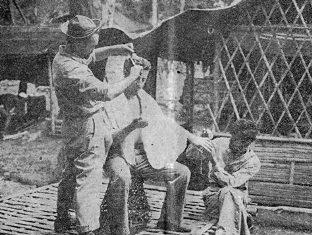 At a Burma station, Pfc. Edward Montgomery spruces up, although many G.I.'s pride themselves on looking like Daniel
Boone. Pvt. Ted Stocks wields the clippers. Sgt. Lee Wadeyka manicures.
At a Burma station, Pfc. Edward Montgomery spruces up, although many G.I.'s pride themselves on looking like Daniel
Boone. Pvt. Ted Stocks wields the clippers. Sgt. Lee Wadeyka manicures.
|
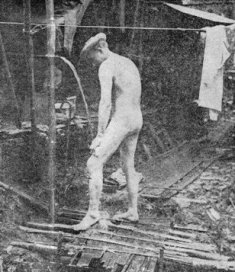 Informality reigns supreme out in the bushes. For instance, one can take a shower with his hat on in perfect comfort -
like Cpl. George Bradof. A bamboo pipe carries the water from a nearby spring.
Informality reigns supreme out in the bushes. For instance, one can take a shower with his hat on in perfect comfort -
like Cpl. George Bradof. A bamboo pipe carries the water from a nearby spring.
|
The boys out in the weeds haven't carpets on the floor, can't ring the butler for a bourbon and soda and would swoon at the sight of a white woman. But after the war is over that they've helped win by roughing it in Burma and Assam, they won't have to invent stories when their grandchildren climb upon their knees an ask, "Tell us about the war, willya, grandpop?" The pictures on this page tell a small part of the story of their experiences. (Roundup photos by T/4 Nick Lyseczko)
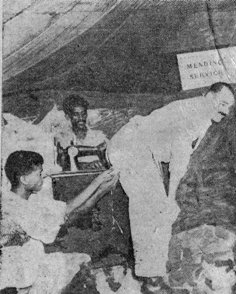 Up at an Assam base, the Red Cross hired Omar the Tentmaker to do clothes mending for G.I.'s. Cpl. Arthur Sherman
is shown getting a rush job done on the seat of his pants, not worn by desk work.
Up at an Assam base, the Red Cross hired Omar the Tentmaker to do clothes mending for G.I.'s. Cpl. Arthur Sherman
is shown getting a rush job done on the seat of his pants, not worn by desk work.
|
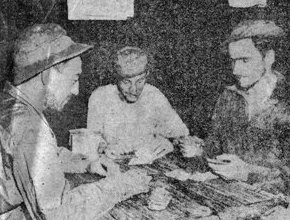 The evenings are long in the tangled jungle and there are no shows, jig palaces and cocktail lounges to eat up the
time. Some of the soldiers do what Cpl. James Bazinau, Cpl. George Bradof and Sgt. George Hill are doing here - wooing
Lady Luck at cards.
The evenings are long in the tangled jungle and there are no shows, jig palaces and cocktail lounges to eat up the
time. Some of the soldiers do what Cpl. James Bazinau, Cpl. George Bradof and Sgt. George Hill are doing here - wooing
Lady Luck at cards.
|
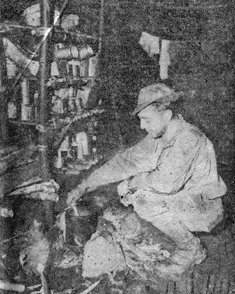 There aren't any fancy cooking ranges or utensils at most places. But a guy soon learns to use his ingenuity. Cpl.
James Bazinau prepares his chow over an open fire, using a No.10 can as a utensil.
There aren't any fancy cooking ranges or utensils at most places. But a guy soon learns to use his ingenuity. Cpl.
James Bazinau prepares his chow over an open fire, using a No.10 can as a utensil.
|
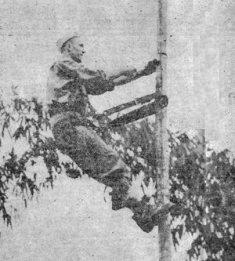 Cpl. Albin Matijasic perches himself on a pole to rig up jungle communications. He has more ups and downs than an
elevator man.
Cpl. Albin Matijasic perches himself on a pole to rig up jungle communications. He has more ups and downs than an
elevator man.
|
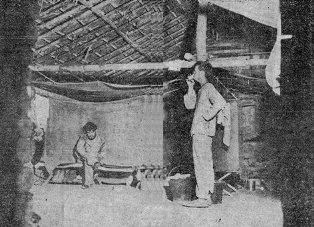 Be it ever so humble, there's no place like home. Making ready for an evening's sleep in their jungle home are Pfc. Russ Mussara, left, and Pvt. Jack Savage. No, it ain't the Astor, but it's theirs.
Be it ever so humble, there's no place like home. Making ready for an evening's sleep in their jungle home are Pfc. Russ Mussara, left, and Pvt. Jack Savage. No, it ain't the Astor, but it's theirs.
|
|
ASSAM - Up where "Leech Road" meets "Baboon Circle" along the India-Burma border, a strange craft plies along a river, chugging and tooting its way from bank to bank. G.I.'s affectionately call it the "sea-jeep." Natives just look at it in wonderment and grin.
But the "sea-jeep" is no joke. Made from an ordinary jeep and two native dug-outs which enable it to float, it is the country cousin to the factory-made city slicker amphibious jeep manufactured in the United States. This one was devised by soldiers of the Services of Supply when they needed a vehicle for amphibious work and had none available.
Two logs were put in place connecting the dug-outs, and the jeep was fastened to the logs. Fin-like attachments were put on the wheels, making the jeep onto a quadruple screw vessel when the gears are shifted to four-wheel drive. It goes along like a paddle-wheel steamer on the Mississippi.
It's a real amphibious craft, this swimming jeep. The nautical attachments can be unbolted quickly and it can go spinning along a road or crashing through a jungle just as it always did. The dug-outs are left on the bank of the river and when the jeep goes out to the sea again it is driven between the dug-outs, bolted down, then a quick shove and once more it chugs along the river.
|
 Simple Ceremony
Simple Ceremony
CHINA - Gen. Claire L. Chennault, Commanding General of the U.S. 14th Air Force, received the Distinguished Flying Cross recently for "Extraordinary achievement in aerial flight."
The medal was pinned on Chennault's chest by Maj. Gen. George E. Stratemeyer, Commander of the American Air Forces in the China-Burma-India Theater, in a simple ceremony in the living room of Chennault's quarters. In addition to Stratemeyer, those present for the presentation were Maj. Gen. H. L. George, Commander of the Air Transport Command; Brig. Gen. Howard C. Davidson, Commander of the 10th Air Force, and Brig. Gen. Edgar Glenn, Chennault's Chief of Staff.
The award was made for Chennault's achievements in keeping the United Nations in the air over China in the face of strong Japanese opposition and technical difficulties of supply and repair. The flying general was commended, not only for his work with the 14th U.S. Air Force, but also for the achievements under his continuous command of the 14th's predecessors, the China Air Task Force and the original American Volunteer Group.
The 53-year-old air tactician has flown in combat zones in the Far East for the last six years - longer, it is believed, than any other American.
GOULDTHRITE FIRST TO BECOME 'ACE' IN SKY DRAGONS
CHINA - S/Sgt. George Gouldthrite, engineer-gunner of a Mitchell medium bomber of the "Sky Dragons," famous bombardment squadron of Maj. Gen. Claire L. Chennault's 14th U.S. Air Force, became the first "ace" of the squadron when he shot down his fifth confirmed Jap Zero on a Sept. 14 mission over Hong Kong. He is the turret gunner in Lt. Col. Morris F. Taber's ship.
Gouldthrite had previously shot down a Zero over Tien Ho airport at Canton, Aug. 20; another over Tien Ho Aug. 26; and two Zeros that made the mistake of attacking his ship on the raid upon the cotton mills at Wuchang on Sept. 10.
This tall, quiet, unassuming gunner has over six years service in the Army, one hitch of which was spent in Hawaii as a member of a field artillery unit.
|
On Vacation
By Sgt. WALTER F. SKORA
HIMALAYAN REST CAMP - Some American boys who have never even been to the zoo back Stateside are proving to be the most enthusiastic of hunters. The sport has become a favorite pastime here, with organized hunting parties leaving every four or five days under the direction of Lt. Kay M. Adams. And although the participants are in every sense tyros, their bags have been quite impressive. Just look at the record:
1 - A 600-pound mountain bear killed by Cpl. A. J. Filipelli.
2 - Indian leopards or panthers averaging from six to eight and one-half feet in length.
3 - Wild boar or pigs averaging from between 200 to 250 pounds.
4 - Several deer and Indian spring buck (for which the lieutenant is still paying fines.)
In addition to these larger animals, small game, such as porcupine and lizards, also abounds.
Each party of embryo Frank Bucks is assigned one of two guides, each hired by the month. Fakir Singh and Rajah Singh know the country like a book. They bring in regular reports on game in the vicinity. Not yet has a tiger been bagged, although there have been several reports of their having molested villagers. The hunt continues.
First come, first served is the credo for the trips. But if a man is not on the regular waiting list, he can arrange to draw arms and ammunition, leave information concerning his tentative destination and push off.
 'THREAT TO INDIA GONE'
'THREAT TO INDIA GONE'
By WALTER L. BRIGGS United Press War Correspondent
Brig. Gen. Caleb V. Haynes told newspapermen before he left the C.B.I. Theater recently for the United States after 18 months of fighting the Japanese from air bases in India and China that, largely as a result of American and R.A.F. operations over Burma, "I don't think there's any threat to India anymore."
"We definitely have them under control in the air," Haynes said. "and I think our efforts have kept the Japs from putting in enough personnel and material to reorganize their forces.
"We have virtually denied them use of the port of Rangoon and badly smashed up their communications system throughout Burma. It's been great preparation for an offensive against Burma."
The stocky, genial general held many important posts in this Theater since pioneering a flight from the United States to India in April, 1942. His most recent job was commander of American air forces at northeastern India bases.
Haynes ferried hundreds of refugees from Burma during the last days of the Japanese campaign there and was the second Army pilot to cross the Himalayas from India with supplies to China. Brig. Gen. Donald Old, the first Army flyer to make the China trip, succeeded Haynes in the northeastern India command.
Haynes said the highlight of his duty in the Far East was the first American mission over Hong Kong which he led in October, 1942, plastering shipping and shooting down 18 of 22 Japanese fighters with the loss of only one P-40 and one B-25.
He stated that he had found the "standard of Jap flying personnel is dropping off, but that new pursuit planes are superior - they are speedier and climb faster - than early Zeros."
Haynes returned with Maj. Gen. Harold George, Air Transport Command chief, who was on a tour of the Theater. It was Haynes' eighth Atlantic crossing.
He told reporters he did not know the nature of his next assignment.
He said his first call when he got home would be on his wife, who works in the draughting department of the Sperry Corp., in Garden City, N.Y. He has a 14-year-old son in high school.
|
WRECKER UNIT IN RESCUE
Cow Pulled To Safety In Thriller
SE INDIA BASE - Of all the strange tales of India, none is more heart-rending than the one of "Bossy in the Well."
The wrecker section of an ordnance company located here was beginning to think the uses of its machinery was exhausted after lifting jeeps off tree-tops and pulling down Indian mud-huts, but upon returning home one evening it was stunned upon finding another job - the removal of a cow from a slit trench.
Two cows had been taken with a frolicsome mood, which ended with one critter being pushed into the slit trench.
Another job was accomplished with that 'ole Ordnance "EFFICIENCY!"
Khaki Laddies Raise Whoopie In Fine Style
By 1st/Sgt. ARTHUS STEIN
CHINA AIR BASE - Midst the glamorous surroundings of the "Bamboo Room," decorated with Chinese lanterns and festooned with flowers, with the sweetly-flowing strains of the 14th Air Force Band under the direction of Lt. Addison Bailey gently caressing the ear and with "Stateside" food and drink to please the palate, Headquarters Squadron of the 14th Air Force on Labor Day entertained 35 lovely ladies in what proved to be the finest, the fanciest, the foremost party of this or any other social season enjoyed by the G.I.'s of China.
Olive-drab blouses, flashing silks of the Orient, sparkling American evening dresses, medals, ribbons and gleaming jewelry combined to form a pleasing picture as the couples whirled across the dance floor in snaky conga chains or jitterbug routines that were a tonic to all the fans of boogie-woogie and the Lindy Hop.
PUNCH BOWL TRIPS
After a few trips to the punch bowl for potent draughts of a soul-warming liquid that concealed an iron poke in a kid glove, everyone left the watching to round-eyed Chinese soldiers and did their best to tear down the roof, floor and walls.
High spot of the evening was the arrival of Maj. Gen. Claire L. Chennault, Brig. Gen. E. E. Glenn, and their party, giving everyone an opportunity to assist in the celebration of the 14th Air Force commander's birthday.
It is seldom that a buck sergeant has the pleasure of cutting in on a major general, so Sgt. Bob Naves gave his "all" in an effort to run the general's chances with a particularly attractive young lady. Interested bystanders, however, seemed to feel that the general would do all right against any competition, and so it proved.
AFFABLE HOST
S/Sgt. George Hutchinson, brain behind the affair, proved to be an affable host. He spent most of his time arranging the dances, sampling the punch and introducing bashful soldiers (the number would surprise you) to charming Chinese girls, who proceeded to teach new dance steps to their astounded partners.
Sgt. Bill Cobb successfully imitated the trumpets of Henry Busse, Clyde McCoy and Harry James, while Pvt. Metcalf and beauteous Frances Weld, of the Red Cross, outwaltzed the rest of the contenders in a heated dance contest.
The Cinderella evening ended promptly at midnight and the truck home was loaded with foot-sore, groggy and happy soldiers.
 BURMA-WISE CHINESE TROOPS
BURMA-WISE CHINESE TROOPS
 These are the type of American-trained Chinese troops which successfully repelled a force of 200 Japs recently during
an attack in Naga country. Left, a jungle-wise infantryman draws careful aim from a concealed position. Center, a
machine gun team moves through a freshly-dug slit trench to take up a position. Right, the crew of a light mortar goes
into action.
(Photos by T/4 Nick Lyseczko, Roundup staff).
These are the type of American-trained Chinese troops which successfully repelled a force of 200 Japs recently during
an attack in Naga country. Left, a jungle-wise infantryman draws careful aim from a concealed position. Center, a
machine gun team moves through a freshly-dug slit trench to take up a position. Right, the crew of a light mortar goes
into action.
(Photos by T/4 Nick Lyseczko, Roundup staff).
Chinese Troops in Burma Repel Attack by Japs
The shadow of things to come fell darkly across Japanese aspirations in Burma recently when American-trained Chinese troops on outpost duty in the Naga country engaged an abortive reconnaissance in force by a unit of 200 Japs.
Significant was the fact that the outnumbered members of VMI-trained Lt. Gen. Li Sun-jen's forces successfully forced the retreat of the attacking force and hammered its communication lines and bridges during the withdrawal.
It proved in their first real taste of blood in the same soggy, muddy, jungle country favored by the enemy that the American-trained Chinese could fight on better than even terms.
CHINESE LOSSES LIGHT
Proper assessment of Japanese losses could not be made because the enemy's withdrawal was orderly and his dead and injured were evacuated. But a communiqu from Lt. Gen. Joseph W. Stilwell's headquarters reported Chinese losses as "light" and those of the attacking force "greater."
The Chinese unit which participated in the skirmish were troops that saw action during the withdrawal from Burma during April and May of 1942 and were rehabilitated and trained at a Chinese-American training base.
SUPPLIED FROM AIR
Last January, they moved into the Naga Hills area and, before the recent clash, had fought only a half dozen minor patrol skirmishes. They have been largely supplies from the air.
The Chinese effectively used their American mortars, British rifles and machine guns in repelling the Japanese attack.
Sun's troops are under the direction of Brig. Gen. Hayden L. Boatner, 42-year-old tough, hard-boiled former Marine.
NEEDED SUPPLIES FLOWN TO ADVANCE BASES BY PLANES;
INTERMITTENT DAMAGE, EXCEPT TO CORN-WILLIE
|
By. Lt. CLANCY TOPP
BURMA OUTPOST - This is one of those unusual Army establishments where there's a minimum of complaint about food and supplies in general.
Everything that comes here is welcome and appreciated, because both officers and enlisted men alike realize that extra effort is spent in getting supplies to places like this - sent special delivery through the medium of air-dropping from American transport planes.
Some of the first air-dropping in the Theater was done more than a year ago, in order to get sorely-needed supplies to Lt. Gen. Joseph W. Stilwell and those who marched out of Burma with him. More dropping was done to the refugees in the mass overland exodus from Burma and also to the retreating Chinese troops plodding toward India. Now air-dropping in this area is on a scale unsurpassed anywhere in the world.
CARRY 'EXTRAS' TOO
In those first weeks and months of air-dropping, only a limited quantity of the most essential supplies could be handled, and in hit-or-miss manner. Today planes are delivering - with a similarity to precision bombing - all of the essentials, plus considerable loads of "extras" that soldiers want.
To the men stationed in these isolated spots, the approach of each plane, weaving in and out among the jungle peaks and fog until the pilot spots the dropping field, creates new suspense - for that very plane might be carrying "specials," such as mail from home, post exchange rations of toilet articles, American cigarettes or American canned beer, as well as magazines, books and newspapers.
There are two methods of discharging loads from planes. For items of a non-fragile nature, the cargo is "free-dropped," no parachute being used as planes fly at "grass-cutting" height. Other loads are discharged with the aid of quick-opening parachutes, the supplies being packed in burlap covered baskets with cushions in the bottom to reduce the jarring.
CORN-WILLIE SAVED
Occasionally, parachutes fail to open and the supplies are partially damaged, but the boys on the scene will tell you that, strangely enough, those accidents never seem to happen to those cases of ever-present corn-willie (corned beef), which always come through in good shape.
The success that air-dropping planes have had is hitting their targets is dependent on the skill of the pilots geared to the accuracy of the men who release the loads. Their job is as dangerous and important as combat or any other kind of flying.
ENGINE CHANGE RECORD
FOR B-24 LIBERATOR BOMBER
By S/Sgt. ROBERT E. BADGER
INDIA AIR BASE - A complete engine change on a Liberator bomber in six hours and 50 minutes!
That's the record chalked up here recently by a crew headed up by Sgt. Joseph B. Fleischmann. Time was inclusive from the time that the first cowling was removed until the engine was ready for run-up.
Work was begun one day at 1300 and was interrupted from 1600 that day until 0800 the next day by heavy rainfall and darkness. In addition to the crew chief, other workers were Sgts. Myron F. Hagglund, Otto W. Schick and Cpls. Ray E. Love, Leo P. Schmelzle, Earl A. Graves, Harold A. Frank, John Houser, Stanton L. Duman and Chris B. Hopkins.
In reporting the record, Lt. Richard C. Hurd declared: "Given the opportunity there is little doubt that this crew or one of the other crews of this detachment can better the above time."
|
Race Home To 'Uncle Sugar'
BETWEEN TWO BUDDIES
 MESSRS. HAYNES, COMBS
MESSRS. HAYNES, COMBS
By S/Sgt. KARL PETERSON
IATF HEADQUARTERS - Brig. Gen. C. V. Haynes and Col. Cecil Combs were old buddies when the former commanded the India Air Task Force and Combs was his Executive Officer. Recently Haynes received those coveted orders for return to "Uncle Sugar." Promptly he received also a flood of congratulatory messages, filled with expressions of farewell and not a little envy, from numerous friends, including Combs. As the general completed preparations for departure and awaited the final word, came one last sly radiogram: "Have just received orders for return to States at once. Will probably leave before you do. Is there anything I can do for you when I arrive? Signed Combs."
He who starts congratulating people on promotions around here doesn't know what he's getting into, as Lt. Col. Blair Sorenson discovered recently. On a flying visit to headquarters, he noticed new major's leaves on former Capt. Charles Dole's shoulders, proceeded to pump Dole's hand and offer best wishes. Then Kenneth Berryhill walked in, also wearing new gold leaves. "Well, jackpot," said Sorenson, and did the honors again. Enter next Harvey J. (Bill) Watkins, wearing a knowing smirk and - the aroused visitor seized him by the collar to confirm it - nice fresh lieutenant colonel's insignia. "Hell, this thing's gotten clear out of hand," said Sorenson, who by now was developing a twitch from peeking at collar lapels. Fortunately for his piece of mind, Capt. Frank Hershey, wearing for the first time his "sweat-stained" railroad track, stayed upstairs.
The promotion which caused the real furor, however, was that of Joe (Our Boy) Rose, who closed a long and distinguished career as a private to enter the non-commissioned ranks as a T/5. Late last week Joe was still demurring salutes and "at-easing" awed fellow soldiers who were overcome (apparently) by his increased stature.
The C.B.I. Roundup is a weekly newspaper published by and for the men of the United States Army Forces in China, Burma, and India, from news and pictures supplied by staff members, soldier correspondents, the United Press, and the Army News Service. The Roundup is published Thursday of each week and is printed by The Statesman in New Delhi, India. Editorial matter should be sent directly to Lt. Floyd Walter, Rear Echelon Hq., U.S.A.F., C.B.I., New Delhi, and should arrive not later than Monday in order to make that week's issue. Pictures must arrive by Sunday and must be negatives or enlargements. Stories should contain full name and organization of sender.

SEPTEMBER 23, 1943
Original issue of C.B.I. Roundup shared by Ruth Canney, widow of CBI veteran John Canney.
Copyright © 2007 Carl Warren Weidenburner
TOP OF PAGE PRINT THIS PAGE ABOUT THIS PAGE SEND COMMENTS
PREVIOUS ISSUE CLOSE THIS WINDOW NEXT ISSUE
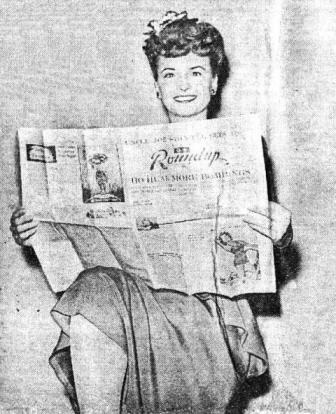 How the Roundup does get around. Actually, we were quite thrilled (pass the tea and crumpets,
Murgatroyed) when we received this picture of Janet Blair reading the fishwrapper. We're almost willing
to adopt Miss Blair as the "Sweetheart of the C.B.I."
She's reading the
How the Roundup does get around. Actually, we were quite thrilled (pass the tea and crumpets,
Murgatroyed) when we received this picture of Janet Blair reading the fishwrapper. We're almost willing
to adopt Miss Blair as the "Sweetheart of the C.B.I."
She's reading the 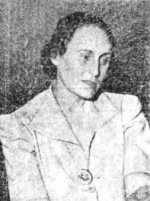
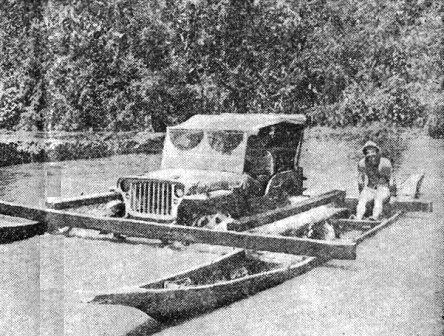
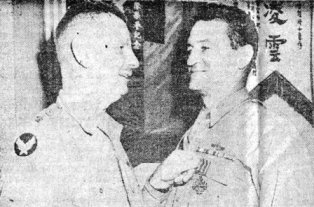 Another honor was bestowed upon Maj. Gen. Claire L. Chennault when the 14th Air Force's commanding genius received
the Distinguished Flying cross. It was pinned upon his chest by Maj. Gen. George E. Stratemeyer, Commander of
the American Air Forces in the C.B.I. Theater.
Another honor was bestowed upon Maj. Gen. Claire L. Chennault when the 14th Air Force's commanding genius received
the Distinguished Flying cross. It was pinned upon his chest by Maj. Gen. George E. Stratemeyer, Commander of
the American Air Forces in the C.B.I. Theater.
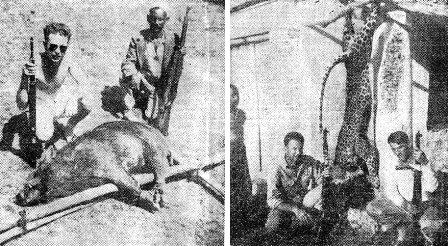 Many G.I.'s vacationing at a Himalayan rest camp are going to boast in the future of their hunting prowess... and
with good reason. S/Sgt. H. H. Henry, left, did better than a Boy Scout job when he knocked off the 250-pound
wild boar with an M-1 rifle. Guide Fakir Singh helped him track the animal. Right, Henry and W. Kirk
smirk into the camera lens with a leopard they bagged that measured eight and one-half feet in length.
Many G.I.'s vacationing at a Himalayan rest camp are going to boast in the future of their hunting prowess... and
with good reason. S/Sgt. H. H. Henry, left, did better than a Boy Scout job when he knocked off the 250-pound
wild boar with an M-1 rifle. Guide Fakir Singh helped him track the animal. Right, Henry and W. Kirk
smirk into the camera lens with a leopard they bagged that measured eight and one-half feet in length.
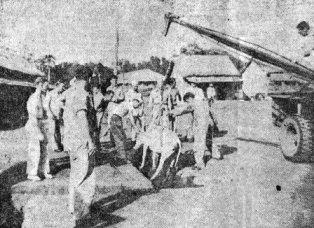 How it was dood.
How it was dood.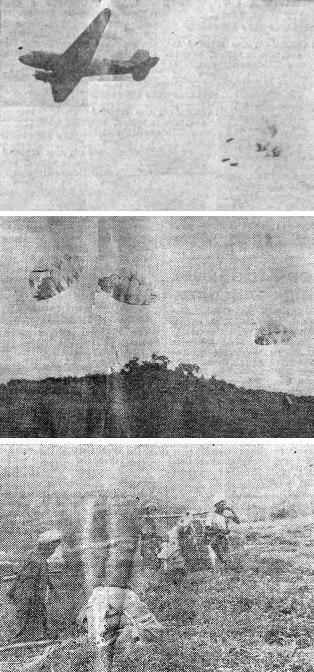 The top panel shows a 10th Air Force plane swooping into an outpost in Burma and parachuting supplies. After
the 'chutes hit the ground with remarkable accuracy as shown in the middle panel, Naga porters collect them in panel
three and transport them to the nearby base.
The top panel shows a 10th Air Force plane swooping into an outpost in Burma and parachuting supplies. After
the 'chutes hit the ground with remarkable accuracy as shown in the middle panel, Naga porters collect them in panel
three and transport them to the nearby base.
